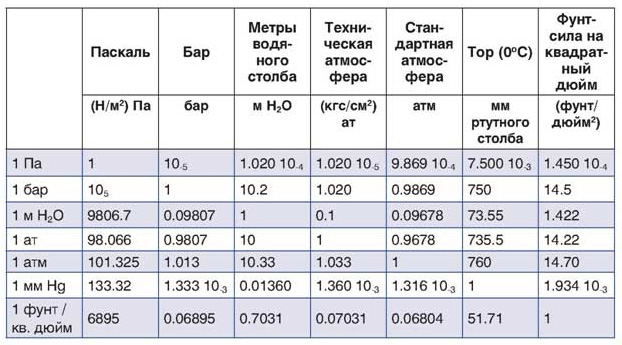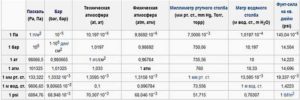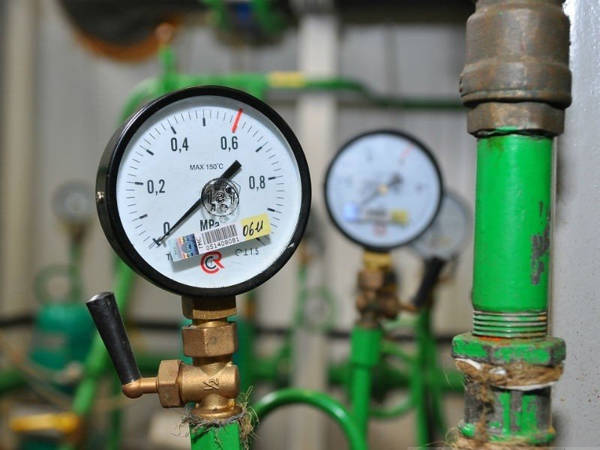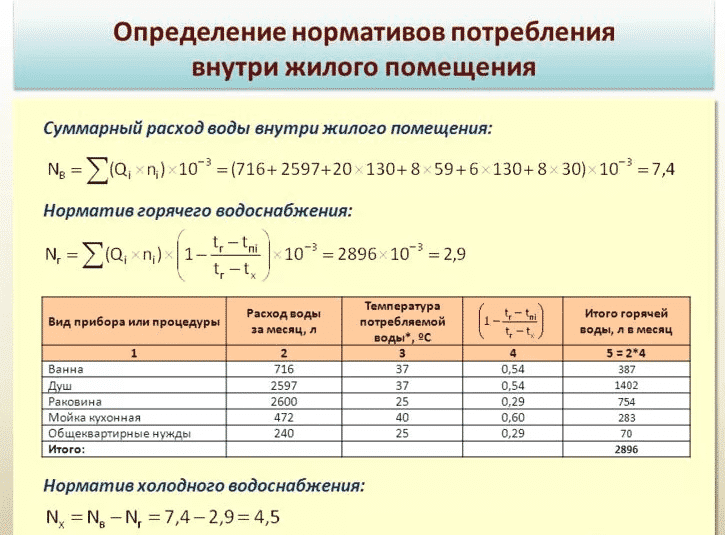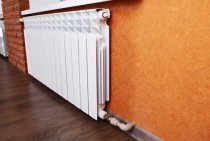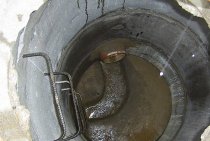The rate of water pressure in an apartment building
The water pressure in the water supply has a great influence on the performance and durability of many household appliances, the operation of which is based on the use of water directly from the water supply, as well as to work as a plumber equipment. For example, at elevated pressure, couplings and valves of household appliances may not withstand, and at reduced pressure, these devices simply will not work.
There are no exact values \u200b\u200bof the pressure in the water supply system for MKD, but it is determined that they should vary from 0.3 to 6 atmospheres:
- for cold water - from 0.3 to 6 atmospheres;
- for hot - from 0.3 to 4.5 atmospheres.
Let's analyze the pressure in the water supply system recommended for various equipment and plumbing equipment in the table:
| Equipment and household appliances | Recommended indicators of water pressure (atmospheres) |
|---|---|
| wash basin | 0,2 |
| toilet | 0,2 |
| shower | 0,3 |
| jacuzzi | 4 |
| washing machine | 2 |
| Dishwasher | 1,5 |
Permissible pressure in the water supply system according to the standard

The water supply system is an engineering communication, the presence of which provides us with a comfortable existence, subject to the main regulatory parameter - the water pressure in the water supply in the apartment. The pressure in the network affects the life of the entire system and household appliances connected to this network.
Standard indicators of pressure in the water supply system
Compliance of apartment parameters with GOST 356-80 will be only if the network hydraulics is brought to the standard. Such indicators are calculated during the installation of a cold water supply system according to SNiP 2.04.02-84. The main factors in this case are the following data:
- Floors and height of the building.
- The number of people living.
- List and quantity of water fittings.
The minimum pressure is one bar or 1.0197 atm. With this indicator, water moves by gravity, and the consumer does not have the opportunity, even on the second floor of a multi-storey building, to simultaneously use several water intake taps.
The maximum allowable pressure value in the city network can reach 15 atmospheres according to GOST 356-80. But with such an indicator, massive network failures are guaranteed. Modern valves are not able to withstand such loads. Therefore, in reality, the pressure in the water supply network is limited to 6-7 atmospheres.
Thus, at a minimum hydraulic value, the consumer will not be able to fully use water, and at the maximum, accidents and breakdowns of plumbing fixtures are guaranteed.
Optimal pressure indicators
To get out of the situation, optimal indicators of network parameters have been developed. The basis for calculating the optimal hydraulics is the rate of fluid consumption per person. According to SNiP, each tenant consumes approximately 4.5 m3 of water per month.
After carrying out calculations that take into account the throughput of intra-apartment pipes, the optimal value for a multi-apartment five-story building of 2.5 - 4.0 atmospheres was deduced.
When designing high-rise residential buildings, a house pumping station is simultaneously calculated, the task of which is to bring water to people from the upper floors. To do this, a pressure pump is installed with the necessary piping and automation.
Household appliances are designed for just such an indicator. For the full operation of an automatic washing machine and dishwasher, 2 atmospheres are enough, and for a shower cabin with a massage function - 4 atmospheres. In the case of installing autonomous heating for the boiler, the optimal pressure is 1.5 - 2.5 atmospheres.
How to correctly calculate the physical parameters for an apartment building
According to the SNiP reference book, the minimum pressure at the input of the first floor is 1 bar, which allows you to create a column of cold water of 10 meters.Then, for each floor, it must be increased by the height of this floor, that is, by an average of 4 meters, which is equal to 0.4 bar. And so the calculation is used for each floor.
By calculation, it is clear that if the number of storeys is higher than the 5th storey, the urban network pressure will be insufficient. And in this case, auxiliary equipment is needed to normalize the indicator. A pump installed individually on an apartment will not give a result. As much as possible, he will be able to increase the pressure to 1.5 atmospheres, which is still not enough for a comfortable stay.
It is also important to know that Decree No. 307 of the Government of the Russian Federation fixed these indicators at the point of parsing an apartment at the level of 0.3-4.5 atmospheres for hot water supply and 0.3 - 6.0 for a cold network
Ways to change the pressure of water
If the network pressure still exceeds the optimal value and the plumbing equipment and household appliances suffer from this, a compensator is installed, adjusted to discharge excess liquid into the sewer. Such cases are very rare. Compensators are used - valves on street water pipes in case of mass complaints from the population of a certain group of houses about exceeding the standard in the network.
More often there are cases of insufficient pressure. And the regulation of the indicator to the optimal value is the immediate task of public utilities.
Ways to increase and decrease the water pressure in the water supply
If for some reason the water supply system has stable low pressure and the organizations servicing the water supply system cannot or do not want to do anything, then the solution may be to install special equipment in the apartment: a pumping station. It consists of a hydraulic accumulator, a centrifugal pump, protective relays and instrumentation.
A simpler option is to install a pump that forcibly pumps water from the network. This method has a significant drawback - it leads to rapid wear of household appliances and plumbing.
How to independently measure the water pressure in the tap - watch the video:
With increased pressure in the water supply, to prevent damage to household appliances and equipment, the pressure must be reduced. This can be done by installing a pressure reducer at the place where the apartment pipe is inserted into the general system.
It should be noted that all work on the above work should be carried out only by specialists licensed to perform these manipulations. It is better if these are employees of the Criminal Code, or specialists invited by them. The fact is that otherwise, in case of any accident in or with a banal leak, the blame for what happened will be placed on the owner of the apartment, where an unauthorized insertion of fixtures into the plumbing system was carried out. Accordingly, material compensation for the damage caused will also have to be paid to the owner of this housing.
Hot water rises higher, cold water lower. It also depends on the purity of the water, fresh or salty, carbonated or still, since all these qualities affect the density of water. If the density of water is 1 gram per cubic centimeter, then the column of water in the pipe will rise 10 meters at a pressure of 1 kg per centimeter square.
A pressure of "1 kg" corresponds to 0.97 atmosphere, i.e. equivalent to 97% of the pressure of a column of air at sea level. In terms of mercury, this is 760 mm. Mercury is 13.55 times heavier than water, so a column of water of 10.3 m will exert the same pressure, multiply by 0.97 and we get exactly 10 meters. It is to such a height that the water column will rise at a pressure in the pipe of "1 kg".
Pressure is measured in Newtons per square meter (N/m2) and not in kg, so the question is not formulated correctly and it is impossible to give a definite answer to it. In addition, the height of the water column at a certain pressure also depends on the size of the nozzle through which the water flows out. The smaller the diameter of the nozzle, the higher the water column rises.
Kilograms are the unit of mass, weight is measured in newtons, and pressure is either kgf/cm2 or N/mm2. I will assume that this is one kilogram of force per centimeter square.
Pressure is the density multiplied by the free fall acceleration by the height of the column and divided by 10.
What water pressure should be in the water supply of an apartment building
Many Russian citizens have faced and continue to face the lack of water at certain times of the day, and only a few guess that it depends on what the water pressure is at that moment in the water supply of the MKD (apartment building).
In order to understand the SNiPs, various Rules, as well as legal acts, it would be more correct to use the help of a specialist. It is better to contact a lawyer or an engineer friend whose work is related to this area.
Our website provides free round-the-clock legal advice online.
With its help, you can easily and without delay get an answer to any legal question.
Regulations governing water supply
If you live, for example, on the top floor of a five-story building, it may be difficult to supply water at night. From about 0:00 to 5:00-6:00 there is no tap water in the apartment at all.
And this situation is observed in many, if not all, cities of the country, which violates the right of citizens established by federal law to receive public services of proper quality.
There are several ways to remedy the situation. They will be discussed in detail below.
What is the reason for the lack of water? It's simple - there is very low pressure in the water supply system. In accordance with the norms established by law, the water pressure in the cold water supply system must be from 0.03 MPa to 0.6 MPa or from 0.3 bar to 6 bar. As for the hot water system, here the lower limit is the same, and the upper limit is slightly lower - 0.45 MPa or 4.5 bar.
Where to go in case of lack of water
Since ensuring normal water supply in the apartment and the house as a whole is the direct responsibility of the managing organization, the first thing to do is to go there and find out why the rules for the provision of public services are being violated. Indeed, in accordance with them, the absence of water for more than 8 hours a month is unacceptable. At the same time, you have the right to demand a recalculation for the days on which you received the service of inadequate quality.
Some apartment owners pay bills not to the management company, but directly to the resource supply organization (it may be called, for example, Gorvodokanal or something else). Then you need to go there, as they deliver water to the borders of your apartment building.
Briefly about the principles of water supply
The level of water pressure in the apartment directly depends on the water pressure in the central, which comes to the house, and that, in turn, depends on the level of water analysis in the network.
The fact is that at a large water intake, from where water enters the city, industrial automatic (in most cases) pumps are installed that pump water from a network of wells that have water pressure limits.
Sometimes there are cases of unscrupulous management of the resource supplying organization. For example, the director of RSO "Gorvodokanal" Kozlov M.M. in order to save electricity, he ordered that at night 7 pumps be turned off, and pressure was reduced in 10. And in total there are 20 of them. It is no wonder that in such conditions the pressure is not enough even up to the second floor of an apartment building.
Litigation
Very often situations arise when you clearly stated in your application that there is no water in the MKD network at night, and employees come during their working hours (which is logical - after all, the Labor Code does not oblige them to work at night). And during the day, the pressure is within the permissible norm. What to do in this case? There are two options:
- or contact an independent expert, who, of course, for a fee, will agree to measure pressure at night;
- or independently buy and install a pressure gauge in your apartment and from time to time make photo and video recording.
Most likely, these materials will even have to go to court.
It all depends on the degree of sympathy of the employees of the organization you applied to, however, it should be borne in mind that the Gorvodokanal (or the same organization with a different name) is only responsible for the supply of such a resource as cold water. But hot water (and heating) is Gorteploseti (or another name - by analogy with Gorvodokanal).
What should be the water pressure in the plumbing
Water is usually supplied to such houses through three systems - for hot and cold water, as well as for heating purposes. Each of these systems has its own standards.
Regulations
All technical systems in buildings are formed in accordance with building regulations and rules, or, if in the abbreviation, SNiPs. For all water supply systems in a multi-storey building, there are SNiPs:
- 2.04.02-84 (cold water supply);
- 2.04.01-85 (internal water supply and sewerage);
- 41-01-2003 (heating, ventilation and air conditioning).
In addition, Decree of the Government of the Russian Federation No. 354 should also be included in the category of basic regulations. It is dedicated to the provision of public services to owners and users of premises in apartment buildings. The appendix to this document contains technical information on parameters for hot and cold water supply, heating, gas supply, electricity supply, sewerage and waste disposal.
Hot water pressure
Pressure is measured in bar. In addition, there is also a measurement in the magnitude of the water column and in atmospheres. One atmosphere is a pressure equal to one kilogram and exerted on an area of one square centimeter. One bar is one atmosphere or ten meters of water.
The higher the apartment is, the greater the pressure in the water pipes should be. With each floor, it should increase by 0.4 bar.
The pressure rate is not determined by a constant, but by a range from the minimum to the maximum value. Going beyond this range is not allowed.
The value range for hot water is between 0.3 and 4.5 bar. The calculation of pressure, taking into account the number of storeys, is carried out according to the formula:
D+(4*n),
Where D is the water pressure in the normal range, 4 is the average floor height, n is the floor number.
In private houses with low floors and low water consumption, the minimum pressure rate is usually determined by a value of 1-2 atmospheres.
Cold water pressure
Cold water must be supplied to the floors under pressure in the range from 0.3 to 6 bar. The increase in the range compared to the indicators for hot water is due to the fact that cold water is consumed in large volumes. It is, for example, used for sewerage. In addition, emergency or planned shutdown of hot water is usually compensated by an increased consumption of cold water, which requires a large pressure.
This range of values is given for the first floor. Calculations for other floors are made according to the above formula.
Pascal's Law
The fundamental basis of modern hydraulics was formed when Blaise Pascal was able to discover that the action of fluid pressure is invariable in any direction. The action of liquid pressure is directed at right angles to the surface area.
If a measuring device (manometer) is placed under a layer of liquid at a certain depth and its sensitive element is directed in different directions, the pressure readings will remain unchanged in any position of the manometer.
That is, the pressure of the liquid does not depend on the change of direction. But the fluid pressure at each level depends on the depth parameter. If the pressure gauge is moved closer to the surface of the liquid, the reading will decrease.
Accordingly, when immersed, the measured readings will increase. Moreover, under conditions of doubling the depth, the pressure parameter will also double.
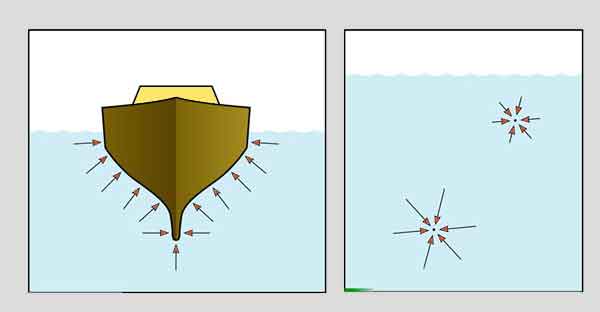
Hence the logical conclusion: the fluid pressure should be considered a directly proportional value for the depth parameter.
As an example, consider a rectangular container measuring 10x10x10 cm, which is filled with water to a depth of 10 cm, which in terms of volume component will equal 10 cm3 of liquid.
This 10 cm3 volume of water weighs 1 kg. Using the available information and the calculation equation, it is not difficult to calculate the pressure at the bottom of the container.
For example: the weight of a column of water with a height of 10 cm and a cross-sectional area of 1 cm2 is 100 g (0.1 kg). Hence the pressure per 1 cm2 area:
P = F / S = 100 / 1 = 100 Pa (0.00099 atmospheres)
If the depth of the water column triples, the weight will already be 3 * 0.1 = 300 g (0.3 kg), and the pressure will triple accordingly.
Thus, the pressure at any depth in a liquid is equal to the weight of the column of liquid at that depth divided by the cross-sectional area of the column.
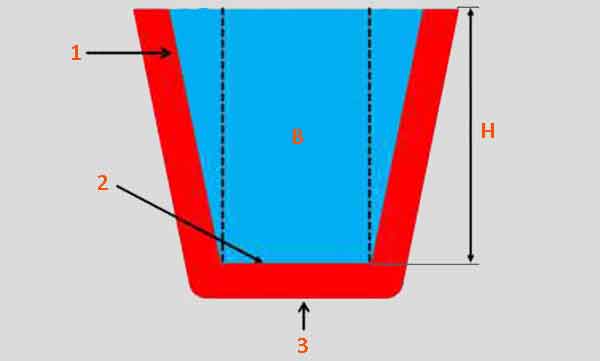
The volume of fluid that creates pressure is called the hydraulic head of the fluid. The fluid pressure, due to the hydraulic head, also remains dependent on the density of the fluid.
Volume and flow rate
The volume of liquid passing through a certain point at a given time is considered as the volume flow or flow rate. The flow volume is usually expressed in liters per minute (L/min) and is related to the relative pressure of the fluid. For example, 10 liters per minute at 2.7 atm.
The flow rate (fluid velocity) is defined as the average speed at which the fluid moves past a given point. Typically expressed in meters per second (m/s) or meters per minute (m/min). Flow rate is an important factor in sizing hydraulic lines.

Volume and flow rate are often considered simultaneously. Ceteris paribus (with the same input volume), the flow rate increases as the section or size of the pipe decreases, and the flow rate decreases as the section increases.
Thus, a slowdown in the flow rate is noted in the wide parts of the pipelines, and in narrow places, on the contrary, the speed increases. At the same time, the volume of water passing through each of these control points remains unchanged.
Bernoulli principle
The well-known Bernoulli principle is built on the logic that the rise (fall) in the pressure of a fluid fluid is always accompanied by a decrease (increase) in speed. Conversely, an increase (decrease) in fluid velocity leads to a decrease (increase) in pressure.
This principle is the basis of a number of familiar plumbing phenomena. As a trivial example, Bernoulli's principle is "guilty" of causing the shower curtain to "pull in" when the user turns on the water.
The difference in pressure outside and inside causes a force on the shower curtain. With this force, the curtain is pulled inward.
Another illustrative example is a perfume bottle with atomizer, when pressing a button creates an area of low pressure due to high air velocity. Air carries liquid with it.
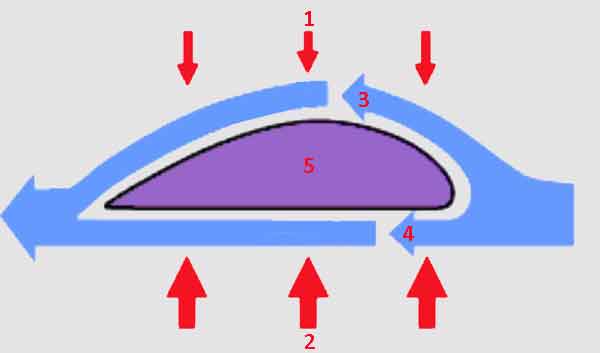
Bernoulli's principle also shows why the windows in a house tend to break spontaneously during hurricanes. In such cases, the extremely high speed of the air outside the window causes the pressure outside to become much less than the pressure inside, where the air remains virtually motionless.
The significant difference in force simply pushes the windows outward, causing the glass to break. So when a major hurricane approaches, one should essentially open the windows as wide as possible to equalize the pressure inside and outside the building.
And a couple more examples when the Bernoulli principle works: the rise of an airplane with the subsequent flight due to the wings and the movement of “curved balls” in baseball.
In both cases, a difference in the speed of air passing past the object from above and below is created. For aircraft wings, the difference in speed is created by the movement of the flaps, in baseball, by the presence of a wavy edge.
The formula used to calculate the pressure level in a water supply system
Having figured out what water pressure should be in an apartment according to the law, you need to understand how experts calculate the norm depending on the number of floors and other indicators. For a low structure, one atmosphere is enough for the pressure to be normal. If there are more floors, then there are additions in the form of 4 m of water. Art. To make an accurate calculation, for example, for a nine-story building, you should use the formula:
10 + 4 x 9 \u003d 46 m of water. Art. = approximately - 5 atmospheres, where:
- 10 - the minimum indicator, that is, a 10 m column equal to one atm.
- 4 - additional meters for each floor.
- 9 - the number of levels in the building.
The result is 46 m, which is approximately equal to five atmospheres. Such a calculation is easy to make for every property owner.
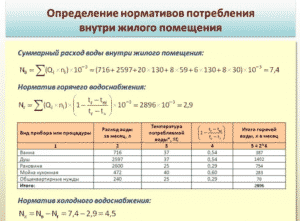
Pressure parameters in the water supply for the normal operation of home appliances
For any household appliances connected to water, pressure matters. If there are constant interruptions, the devices may fail or function incorrectly.
When the water supply is central, then the parameters must clearly comply with the standards, no matter if a person lives in Moscow or in any other city in Russia
The main normative values approved at the legislative level:
Table 1.
| Devices | Atm. |
|---|---|
| Wash basin with mixer | 0,2 |
| Bath, shower | 0,3 |
| Toilet | 0,2 |
| Bidet | 0,3 |
| Jacuzzi | 4 |
| washing car | 2 |
| Boiler equipment | 1,5-2,5 |
| Watering the garden | 2 |
| Dishwasher | 2,5 |
Danger of strong water pressure
Some people are happy when their taps are full of water, but they do not even think about the fact that breaking the rules can result in a serious problem. Strong pressure can damage household appliances or provoke a pipe break.
Four atmospheres is an acceptable indicator. If the pressure exceeds 4.5 atm. and the landlord noticed this, then you should not be inactive, but you need to notify Vodokanal.
Consequences of low water pressure
At very high water pressure, a real tragedy can occur. Its scale will be directly affected by the height of the building. If this is a high-rise building, then there is a risk of flooding the entire MKD. Further, the entire pipeline will fail and the property of citizens will suffer. Therefore, apartment owners must control the level of pressure and, in case of deviation from the standard, contact the housing office, management company or Vodokanal.
Tips on how to determine the pressure in the water supply
Water pressure can be measured using an instrument called a water pressure gauge. There is a household version for home use with an adapter for connecting to equipment, such as a kitchen faucet.
There is a method for measuring pressure without using a pressure gauge. To do this, you need a 3-liter jar and a stopwatch (or a watch with a second hand).It is necessary to open the tap at full capacity, substitute the jar and note the time. After filling, you need to note the time for which the jar was filled. It will become a key indicator for determining pressure. Empirically and by calculation, it was established that the filling time of the jar and the pressure in the water supply correspond.
Let's look at this ratio in more detail in the table:
| Pressure in the water supply network (atmospheres) | Can fill time (seconds) |
|---|---|
| 0,10 | 14 |
| 0,14 | 13 |
| 0,19 | 10 |
| 0,24 | 9,5 |
| 0,34 | 8 |
These indicators are very approximate, and therefore can only become the basis for calling representatives of the management company to conduct official measurements using special equipment.
